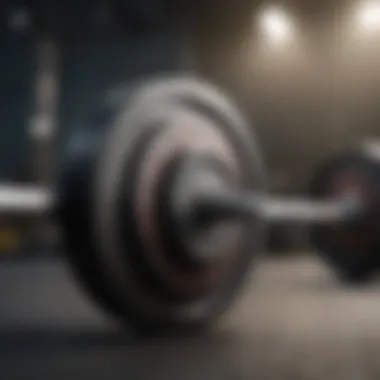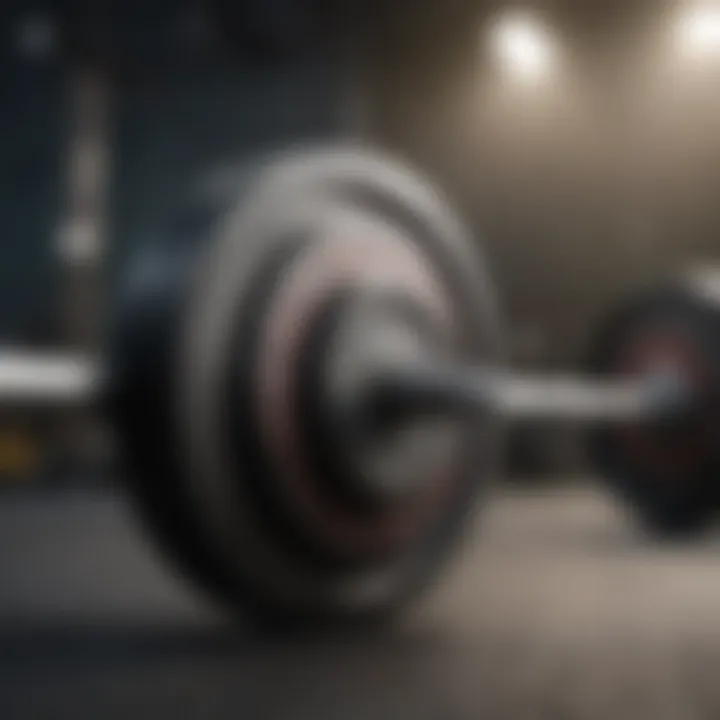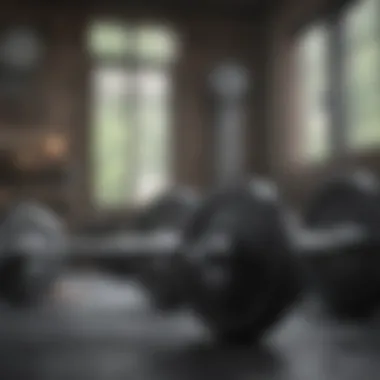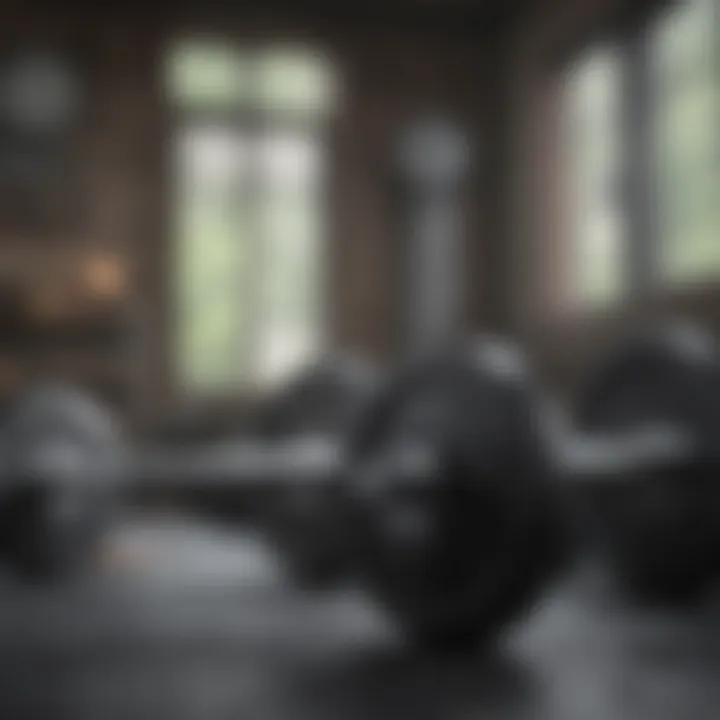Comprehensive Guide to Home Barbells for Fitness


Key Benefits
Physical Health Benefits
Incorporating home barbells into a fitness routine offers numerous physical health benefits. Strength training enhances muscle mass, which can contribute to better metabolism and overall fat loss. Research indicates that lifting weights could lead to improvements in bone density, decreasing the risk of osteoporosis as one ages. Furthermore, using barbells can improve functional strength, helping with daily activities and increasing overall performance in various physical tasks.
The versatility of barbells allows for a wide range of exercises targeting different muscle groups. Common exercises such as deadlifts, squats, and bench presses promote strength not only in major muscle groups but also in stabilizing muscles. This kind of strength enhancement can translate into better balance and coordination, minimizing risks of falls, especially for older adults.
Mental Well-being Enhancements
The benefits of home barbells extend beyond the physical. Engaging in regular strength training is known to have positive effects on mental health. It can reduce symptoms of anxiety and depression, foster a sense of accomplishment, and improve self-esteem. The process of setting fitness goals, monitoring progress, and achieving them can provide individuals with a greater sense of control over their health and well-being.
Moreover, strength training can trigger the release of endorphins, often referred to as "feel-good" hormones. A consistent workout regimen using barbells can help create a productive routine, contributing positively to one's mental clarity and focus. By integrating these workouts into daily life, individuals may also find it easier to manage stress and improve their overall quality of life.
"Regular physical activity can bring about significant changes in mood and provide an emotional outlet when dealing with everyday stresses."
Practical Tips
Effective Meal Planning
Nutrition plays a vital role in achieving fitness goals when using home barbells. Meal planning can enhance workout results significantly. Focus on incorporating a variety of protein sources, like lean meats, legumes, and dairy products. These foods help repair muscles after strength training sessions and foster growth. Consider including complex carbohydrates and plenty of vegetables to obtain necessary vitamins and minerals.
An effective meal preparation schedule may look like this:
- Plan meals weekly to align with workout days.
- Prepare meals ahead of time, storing them properly to maintain freshness.
- Stay hydrated—drink water consistently throughout the day.
Quick and Efficient Workouts
Time can often be a barrier to exercising. However, utilizing home barbells enables individuals to design quick yet efficient workouts. Focusing on compound exercises that work multiple muscle groups simultaneously can save time while maximizing effort. Examples of such exercises include squats, deadlifts, and overhead presses.
Consider the following structure for effective barbell workouts:
- Warm-up: Spend five to ten minutes on light cardio and mobility drills.
- Compound exercises: Perform 2-3 sets of major lifts focusing on form and gradual weight increase.
- Accessory exercises: Include smaller movements addressing specific muscle weaknesses, ideally focusing on higher reps for endurance.
- Cool down: Stretch and allow muscles to relax after a workout.
By integrating home barbells into a routine, individuals can foster both physical and mental well-being while ensuring efficient use of time and resources.
Prelude to Home Barbells
Home barbells have gained prominence in fitness routines as individuals seek more flexibility and convenience in their workouts. The idea of working out at home resonates deeply with people for various reasons, especially in recent years. The pandemic reinforced the need for effective home workout solutions, making home barbells more than just a preference. They have become an essential component of personal fitness.
Adopting home barbells gives one several advantages. First, they allow for a broad range of exercises that target different muscle groups. This equipment is not only versatile but also effective in enhancing strength, flexibility, and endurance. Daily routines can incorporate various movements, from squats to deadlifts, which are crucial for balanced physical development.
Definition and Overview
A home barbell is a piece of fitness equipment, typically a long rod with weights attached at both ends, designed for performing resistance training exercises. They come in various sizes and weights. Most common types include standard barbells, Olympic barbells, adjustable models, and hex barbells. Each type serves distinct purposes and caters to different fitness levels.
When discussing home barbells, it is also important to address their components. A standard barbell usually has a length of about 5 to 7 feet and weighs around 45 pounds. However, adjustable barbells can weigh less or more, allowing for customization based on the user’s strength and workout goals. Weight plates can be added to increase resistance, making barbell training adaptable as one progresses.
The Role of Barbells in Fitness
Barbells are integral to strength training routines. They enable effective load management, which is critical for progressive overload, a key principle in muscle growth and strength gain. With barbells, various exercises can be performed, including bench presses, squats, and rows.
In addition, barbells support balanced functional training, essential for everyday movements. Engaging multiple muscle groups enhances coordination and stability, which is beneficial in various physical activities.
"Incorporating barbells into your fitness routine not only builds strength but also fosters discipline and consistency in your exercise regimen."
Understanding their role in fitness highlights the importance of selecting the right barbell based on personal goals. This choice can directly impact the effectiveness of a workout regimen. Barbells allow for tailored training, adapting to individual progress and objectives. Thus, they are crucial in home fitness, where personal customization is often paramount.
Types of Home Barbells
Home barbells are fundamental tools for strength training and muscle development. Understanding the different types of home barbells aids in making an informed decision, allowing you to optimize your workouts. Each type of barbell has distinct characteristics that cater to various fitness levels and personal preferences. Selecting the right one can enhance your performance, improve workout efficiency, and ensure safety during exercises.
Standard Barbells
Standard barbells are usually shorter and lighter than their Olympic counterparts, designed for regular weight plates. These barbells often measure around 5 to 6 feet in length and come with a diameter of about 1 inch. They are ideal for beginners or individuals with limited space.
- Benefits: Standard barbells are generally more affordable and versatile. They can be used for a wide range of exercises like squats, presses, and deadlifts.
- Consideration: They have a limited weight capacity compared to Olympic barbells. For serious lifters or those wanting to progress in strength, they may not be the best option long-term.
Olympic Barbells
Olympic barbells are the gold standard in strength training, notably used in professional lifting competitions. They are longer, typically measuring 7 feet, with a diameter of about 2 inches. Olympic bars can handle heavier weights, essential for advanced lifters.
- Benefits: They offer superior durability and stability due to their design and construction. The increased weight capacity allows for heavier progressive overload, crucial for muscle growth.
- Consideration: The size and weight may not be suitable for everyone, especially those with smaller lifting areas or who are new to barbell training.
Adjustable Barbells
Adjustable barbells are a versatile option for home training. They usually feature removable weight plates, enabling users to tailor the weight according to their fitness level. This adaptability makes them suitable for various exercises and training intensities.
- Benefits: They save space and are budget-friendly since one equipment piece can replace multiple weights. This is particularly advantageous for those with limited workout areas.
- Consideration: The process of adjusting weights may interrupt workout flow, which can be frustrating during high-intensity sessions.
Hex Barbells
Hex barbells have a unique shape, often resembling a hexagon. This design is crafted to provide enhanced grip and stability during exercises. These barbells are generally used for specific lifts such as deadlifts or shrugs.
- Benefits: The shape minimizes the risk of rolling when set down, making them safe to use in any workout environment. Their ergonomic design fits naturally in the hands, which can reduce strain during lifts.
- Consideration: They tend to be less common in traditional home gyms focused on barbell training and may require additional investment in specialized implements.
Key Components of Barbells
Understanding the key components of barbells is essential for anyone looking to optimize their fitness experience. Each part of the barbell serves a unique purpose and can significantly influence how effective your workouts will be. When combined correctly, these components ensure stability, safety, and an overall efficient training session. This section breaks down the fundamental elements of barbells: bar length and diameter, weight plates, and collars and grips.
Bar Length and Diameter
Bar length and diameter are critical factors in determining how a barbell performs and feels during workouts. Different bar lengths cater to various exercise needs and space availability. Standard barbells typically measure about 6 feet, while Olympic barbells are slightly longer at around 7 feet. The diameter of the bar is also important; standard bars usually have a diameter of about 1 inch, while Olympic bars have a larger diameter of 2 inches.
The diameter influences grip strength and comfort. A wider bar may challenge grip stability, promoting better muscle engagement during lifts. The choice between standard and Olympic sizes often comes down to personal preference and fitness level. If you are new, beginning with a standard bar may feel more manageable.
Weight Plates
Weight plates are an essential part of barbells, as they allow for progressive overload—crucial for muscle growth. There are different types of weight plates available, such as bumper plates and cast iron plates. Bumper plates are typically used in Olympic lifting, as they are designed to withstand repeated drops without risking damage to the floors or the plates themselves.


When choosing weight plates, consider their weight increments. Having a varied range of weights facilitates gradual increases in strength and leaves room for improvement as you progress. Ensure the plates are compatible with your barbell type, as standard plates will not fit on Olympic bars.
Collars and Grips
Collars are the small clamps that secure weight plates onto the barbell. They play a vital role in workout safety. If collars are not fixed appropriately, the weight plates can slide off during exercises, leading to accidents. There are various types of collars available, including spring collars, locking collars, and quick-release collars. Selecting the right type of collars can enhance your lifting experience, ensuring that your weights remain stable throughout the movements.
Moreover, the grips of the barbell are another key factor in comfort and performance. The texture and material of the grips can influence how securely you can hold onto the bar during different exercises. A knurled grip often provides a better hold, even with moisture.
The importance of understanding barbell components cannot be overstated; they directly affect your performance and safety during workouts.
Closure
Choosing the right barbell components is much more than a mere selection process. It involves understanding how these components work together to maximize your training effectiveness. By paying attention to the bar length and diameter, weight plates, and collars and grips, you can enhance your strength training experience, ensuring sustainable progress and safety in your workouts.
Selecting the Right Barbell
Selecting the right barbell may appear to be a simple task, but it involves careful consideration. A barbell is a significant investment for anyone who wants to pursue strength training at home. It is not just a fitness tool; it is the central piece of many workout routines. Choosing the appropriate barbell can enhance your performance, ensuring that your workout aligns with your fitness aspirations.
Consider Your Fitness Goals
Before making a decision, reflect on what you want to achieve. Are you aiming for strength gains, muscle hypertrophy, or endurance? Each goal might require a different type of barbell.
- For strength training, Olympic barbells are often recommended because they can hold heavier weights.
- If muscle growth is your primary focus, you may prefer adjustable barbells. They allow for progressive overload with various weight options.
- For endurance training, lighter barbells or hex bars might be sufficient.
Clearly defining your objectives helps narrow your choice. A mismatched barbell can lead to injuries or hinder your progress.
Assess Your Space
The physical space where you plan to store and use the barbell is crucial. Consider not only the space for the barbell itself, but also the area needed for your exercises. Here are some factors to think about:
- Ceiling Height: Ensure it is high enough for overhead lifts.
- Floor Space: You need room to move comfortably. Check if you have enough space to perform squats and deadlifts safely.
- Storage Solutions: If space is tight, think about collapsible or adjustable barbells that take up less room when not in use.
Evaluating your workout area can prevent accidents and ensure your exercise environment is well organized.
Budget Considerations
Budget plays a significant role in selecting a barbell. High-quality options are available at various price points, but it is wise to reflect on what you are willing to invest.
- Quality vs. Price: Cheaper barbells may save upfront costs, but often they come with longer-term disadvantages due to lower durability.
- Long-term Investment: High-quality barbells may seem costly, but they can last for years and withstand heavy loads, providing better value.
- Additional Costs: Remember to factor in any additional weight plates or accessories you may need.
Remaining within budget, but not compromising on quality, is essential for making a wise purchase.
Keep in mind: A thorough evaluation of your fitness goals, available space, and budget will guide you to the right barbell for your home workouts.
Barbell Maintenance and Care
Maintaining your barbell is essential for longevity and performance. Regular maintenance ensures optimal function during workouts and promotes safety. Over time, corrosion, dirt, and wear can affect the quality of your equipment. Neglecting these needs can lead to failures that may cause injuries.
Cleaning and Storage
Regular cleaning of your barbells helps prevent rust and deterioration. Depending on the frequency of use, it is important to wipe down bars with a soft cloth after each workout to remove any sweat or moisture. This prevents corrosion and keeps the finish intact. For deeper cleaning, use appropriate cleansers that do not damage the metal. Avoid harsh chemicals that can strip the protective coatings.
Proper storage also plays a significant role in maintenance. Store your barbells in a designated area, ideally in a dry place. Use wall mounts or floor stands to keep them off the ground. This minimizes the risk of accidental drops or damage. If you must stack them, use padded mats in between to avoid scratches and promote safety.
"Proper care extends the lifespan of your barbell and enhances performance."
Inspecting for Damage
Regular inspection of your barbells is crucial to ensure they are in safe condition. Look closely for any signs of bending, cracks, or rust spots. Most problems may not be evident at a glance. Be specific about the areas around the sleeves and shaft, as these are more prone to wear due to the nature of use and weight.
If you notice any unusual noises during use or if the bar feels different while lifted, it may indicate internal damage. In such cases, it is usually preferable to consult a professional for evaluation or consider replacing the bar. This proactive approach not only secures your safety but also ensures that your workout remains effective.
In summary, the maintenance of your barbell through cleaning, proper storage, and regular inspections is key to maximizing its lifespan and safety. Making these practices a routine part of your workout helps you avoid costly replacements and ensures safety during workouts.
Essential Techniques for Barbell Exercises
Understanding essential techniques for barbell exercises is crucial for anyone looking to maximize their fitness potential. Proper techniques help ensure that workouts are effective and minimize the risk of injury. Mastering alignment and breathing techniques can dramatically enhance performance during strength training. This section delves into these techniques, offering insights on proper lifting alignment and effective breathing.
Proper Lifting Alignment
Proper lifting alignment involves maintaining the correct posture and positioning of the body while performing exercises. It is essential to align the spine, shoulders, and hips to facilitate safe and effective lifts.
- Feet Position: Start with your feet shoulder-width apart. This stance provides a stable base and allows for better balance.
- Grip: Your grip on the barbell is critical. Ensure that your hands are positioned evenly. A common grip is just wider than shoulder-width, depending on the exercise. For example, in squats, your grip can be slightly narrower.
- Back Position: Keep your back straight and slightly arched. Avoid rounding your back to prevent strain. This is particularly important during heavy lifts such as the deadlift or bench press.
- Knees and Elbows: When lifting, ensure that your knees do not extend beyond your toes to maintain joint stability. Similarly, keep your elbows tucked in during movements like the bench press to engage the correct muscles.
- Head Position: Keep your head in a neutral position, looking straight ahead. Avoid tucking your chin into your chest or craning your neck upwards.
By mastering proper lifting alignment, you can lift heavier weights safely and efficiently. Failing to adhere to these guidelines can result in poor form, leading to overuse injuries or acute damage.
Breathing Techniques
Breathing techniques are crucial for sustaining effort and maximizing performance during barbell exercises. Proper breathing can help stabilize the core, providing support for the spine and enhancing overall strength.
- Breathe During Lifts: Inhale deeply before initiating the lift. Hold that breath as you begin the lift to create intra-abdominal pressure. This pressure helps stabilize your core and spine.
- Exhale on Effort: Exhale when you exert force. For example, when pushing the barbell upwards in a bench press or standing up from a squat, allow the breath to guide the effort. This controlled exhalation can improve power output.
- Rhythmic Breathing: Establish a consistent rhythm for breathing. This rhythm can improve focus and coordination. Knowing when to inhale and exhale can keep you grounded.
- Avoid Shallow Breathing: Shallow or rushed breaths can limit oxygen intake, affecting your endurance and stamina. Focus on deep, measured breaths both at rest and while lifting.
By integrating these techniques, you embrace a holistic approach to barbell training. Engaging your core and maintaining proper lifting alignment prepares you to lift more effective and enhances your overall workout experience.
"Mastering proper techniques in lifting and breathing can be differentiators in achieving fitness goals successfully."
Safety Precautions with Barbells
In any fitness regime, prioritization of safety is crucial, especially when incorporating barbells into your workout. Barbells provide versatile training options but also carry risks of injury if not used correctly. Ensuring proper safety measures can enhance the workout experience while reducing the potential for harm.
Preventing Injuries
Preventing injuries is the foremost aspect of barbell training. Both experienced lifters and beginners must adhere to strict safety protocols to mitigate risks. Here are several key strategies:
- Proper Warm-Up: Engaging in a thorough warm-up session prepares the muscles and joints for the stress they will endure. A minimum of 5 to 10 minutes of dynamic stretching is advisable.
- Correct Technique: Understanding and mastering the correct posture for each exercise is critical. This not only maximizes effectiveness but also protects against strains and sprains. Consider enlisting expert guidance to learn proper form.
- Start Small: Especially for beginners, starting with lighter weights allows the body to adjust progressively. Gradually increasing weight can help build strength without overexerting.
- Use Appropriate Footwear: The right shoes provide stability and support. Avoid training barefoot or in sandals, as this increases the risk of slips or falls.
- Avoid Overtraining: Listen to your body. Pushing beyond your limits can lead to fatigue, increasing vulnerability to injuries. Incorporate rest days into your training schedule.
"Injury prevention should always come before performance enhancement. It sets the foundation for a sustainable training program."
Using Spotters


Utilizing a spotter is an essential safety measure during barbell workouts, particularly for free weight exercises like bench press or squat. A spotter's primary role is to assist and ensure safety, effectively reducing the risk of accidents. Here are some key considerations when using spotters:
- Communication: Clear communication between the lifter and spotter is vital. The lifter should explain their lifting strategy and any specific cues, such as when to assist or how much help is needed.
- Positioning: The spotter should position themselves appropriately. For example, during bench presses, the spotter should stand with their hands ready to aid but not intrusive to the lifter's movement.
- Regular Practice: Spotting should be practiced, just like any exercise. The spotter should feel comfortable with the weight being lifted and know how to react in case of emergencies.
Integrating these safety precautions and practices will increase the benefits achieved through barbell training while minimizing the risk of injuries. It builds a sound foundation for health and fitness objectives.
Home Barbell Workout Routines
Home barbell workout routines are essential for individuals aiming to enhance their fitness levels from the comfort of their homes. These routines provide a structured approach to strength training and help in achieving various fitness goals. Utilizing barbells enables targeted muscle engagement compared to bodyweight exercises, making it a valuable component in any fitness regimen.
Strength Training Programs
Strength training programs that incorporate barbells are vital for building muscle and increasing strength. These programs can be tailored to meet specific goals such as gaining muscle mass, reducing body fat, or improving overall athletic performance.
When designing a strength training program, consider the following:
- Frequency: Train each muscle group at least twice a week to stimulate growth and strength.
- Volume: Aim for the correct number of sets and reps for your experience level. Beginners may start with lighter weights and focus on form.
- Intensity: Adjust weights according to your capability. The last couple of reps should be challenging but achievable.
Common barbell exercises include the bench press, deadlift, and squat, each targeting multiple muscle groups. Incorporating variations in these movements can reduce plateauing and keep workouts engaging. Each session should aim for progressive overload to foster continuous improvement.
Progressive Overload Principles
Progressive overload is a crucial principle in strength training that involves gradually increasing the weight, frequency, or intensity of workouts. This concept is fundamental for muscle growth and strength development.
To effectively implement this principle, incorporate the following strategies:
- Increase Weight: Incrementally add weight to exercises as strength improves to ensure continued challenge.
- Adjust Repetition and Set Schemes: Vary the number of reps and sets in each workout to stimulate muscles differently. For instance, you might shift from 3 sets of 10 reps to 4 sets of 6 reps.
- Modify Rest Periods: Altering rest periods between sets can affect the intensity of workouts. Shorter rest may enhance endurance while longer rest allows for heavier lifts.
By adhering to the principles of progressive overload, individuals can maximize their workouts and ultimately achieve their desired fitness outcomes. Regularly assessing progress helps identify when adjustments are necessary.
"Regularly revisiting your workout strategy allows for sustained progress and prevents stagnation in fitness goals."
In summary, home barbell workout routines are more than just exercises; they provide a framework for achieving measurable physical changes. Tailoring strength training programs and embracing progressive overload are fundamental to optimizing fitness results.
Barbell Workouts for Different Fitness Levels
Barbell workouts provide a versatile tool for strength training, accommodating all fitness levels. Understanding how to tailor workouts according to specific fitness stages is crucial. Different levels call for unique approaches to maximize effectiveness and ensure safety. This section delves into appropriate workouts for beginners, intermediates, and advanced lifters. Each stage presents its challenges, benefits, and necessary considerations.
Beginner Level
For beginners, the focus should be on mastering form and technique before increasing the weight. Starting with basic movements such as the squat, deadlift, and bench press will create a strong foundation. These exercises engage multiple muscle groups, promoting balanced strength development. Beginners should prioritize light to moderate weights to prevent injuries and build confidence.
Key Considerations for Beginners:
- Emphasize proper form over heavy weights.
- Use a mirror or take videos to check techniques.
- Consider working with a trainer initially, if possible.
Basic Beginner Routine Suggestion:
- Barbell Squats: 3 sets of 8-12 reps.
- Bench Press: 3 sets of 8-10 reps.
- Deadlifts: 3 sets of 8-10 reps.
This routine emphasizes the correct execution of movements, helping beginners to transpose their understanding into strength gains.
Intermediate Level
Intermediate lifters should focus on progressive overload and variety in their workouts. At this stage, it's important to introduce new exercises or increase the weight of existing ones. Additionally, incorporating accessory lifts can help target specific muscle weaknesses and enhance overall performance.
Key Benefits of Intermediate Workouts:
- Greater strength gains through increased weight.
- More complex movements can be introduced.
- The opportunity to refine techniques further.
Sample Intermediate Routine:
- Barbell Squats: 4 sets of 6-10 reps with increased weight.
- Deadlifts: 4 sets of 6-8 reps, focusing on form.
- Overhead Press: 3 sets of 6-10 reps, enhancing upper body strength.
- Barbell Rows: 3 sets of 8-10 reps for back strength.
By integrating more advanced techniques like drop sets or pyramid sets, intermediates can significantly enhance their workout efficacy.
Advanced Level
Advanced lifters have likely mastered form and can handle heavier weights with little risk of injury. The focus shifts to specific goals, such as building maximal strength or enhancing muscular endurance. Advanced routines often include periodization strategies to prevent plateauing and promote long-term progress.
Considerations for Advanced Training:
- Incorporate varied rep ranges to shock the muscles.
- Focus on compound movements for overall mass gain.
- Include deload weeks to allow muscle recovery.
Sample Advanced Routine:
- Barbell Squats: 5 sets of 5 reps at maximal weight.
- Deadlifts: 5 sets of 3-5 reps, emphasizing strength.
- Daily Undulating Periodization (DUP): Vary reps each day to enhance lifts.
- Power Cleans or Snatches: 4 sets of 3-5 reps to improve explosive strength.
Each fitness level requires tailored approaches to ensure safe, effective workouts that promote continuous improvement and keep engagement high. Regardless of level, consistency and proper technique are always keys to success in any barbell routine.
Integrating Barbells into a Home Gym
Integrating barbells into a home gym setup is essencial for maximizing workout potential. The inclusion of barbells provides versatility and depth to fitness routines, allowing for a variety of exercises that target multiple muscle groups. Home gym enthusiasts often seek to recreate the free weights environment of a commercial gym. By incorporating barbells, users gain the ability to perform traditional lifts such as squats, deadlifts, and bench presses, which are fundamental for building strength.
Creating Effective Spaces
When designing a home gym, effective space utilization is crucial. A clean, organized area not only maintains focus but also enhances safety during workouts. Consider the following elements:
- Space Measurement: Measure the area available for your gym before purchasing equipment. Ensure enough room for movement around the barbell and for weight changing.
- Flooring: Invest in quality flooring that absorbs impact. Rubber mats are ideal for protecting floors and minimizing noise.
- Lighting and Ventilation: Good lighting can motivate while proper ventilation keeps the area comfortable. Natural lighting is preferred, but adding adjustable lighting options can help during evening workouts.
- Defined Zones: Establish zones for different workout types. One area for lifting with barbells and another for cardio or stretching can aid in maintaining focus.
Unifying these elements creates a welcoming environment that encourages regular use and sustainability in fitness goals.
Essential Accessories for Barbells
Accessories can enhance the functionality of barbells in a home gym. Below are some essential accessories:
- Weight Plates: Standard plates, Olympic plates, and bumper plates cater to various training needs and user experience levels.
- Collars: Secure weight plates with collars to prevent them from sliding during lifts. This ensures safety and allows for heavier lifts.
- Barbell Rack: A dedicated space for storing barbells protects them from damage and keeps your gym organized.
- Bench: An adjustable bench can enhance the number of exercises available while promoting correct lifting posture.
Incorporating these accessories elevates the overall training experience while expanding exercise variety and ensuring safety.


"Creating a dedicated space for barbell workouts enables individuals to focus on performance and technique, ultimately leading to better progress and results."
Through careful integration and planning, barbells can become an integral part of any home gym, providing significant advantages in terms of strength training, versatility, and convenience.
Comparative Advantages of Home Barbells
Home barbells serve as a fundamental tool for individuals aiming to enhance their fitness levels from the comfort of their own residence. This section explores the comparative advantages that home barbells bring to personal fitness routines. Understanding these benefits can guide individuals in making informed decisions about incorporating barbells into their workout regimens.
Cost-Effectiveness
Investing in home barbells can be significantly more cost-effective than paying for a gym membership. While initial costs for purchasing quality equipment may seem high, over time, these expenses can be offset by the savings from not needing to pay monthly fees. Moreover, barbells are versatile and allow for a wide range of exercises, eliminating the need to buy multiple machines or gym memberships.
- Many home barbells are built to last, meaning they do not require frequent replacement.
- Purchasing weights in increments can allow users to gradually build their collection, adapting their purchases to evolving fitness goals without overspending.
- Barbell routines can efficiently target multiple muscle groups, providing the benefits of a full gym workout at a fraction of the cost.
The value proposition of home barbells becomes more apparent when considering the cost of personal training sessions, travel to the gym, and possibly even time lost. For those with budget constraints, home barbells present an economic opportunity to achieve fitness objectives without sacrificing quality or results.
Flexibility and Convenience
Barbells also offer extraordinary flexibility and convenience for users. They allow individuals to engage in workouts on their own schedules, providing a tailored fitness experience that aligns with busy lives.
- Workout Timing: Users can exercise whenever they prefer, avoiding rigid gym schedules. This eliminates the pressure of planning workouts around gym hours or peak times.
- Customizable Workouts: Home workouts can be designed to fit personal preferences, focusing on specific goals such as strength, endurance, or muscle definition without conforming to pre-set gym classes.
- Space Efficiency: A set of barbells can fit into smaller spaces, making them a suitable option for those with limited room. There are adjustable options that save space while providing numerous weight increments, enhancing the appeal for urban dwellers.
The ability to work out at home not only saves time but also provides a safe space for individuals to try new techniques without the judgmental atmosphere that some may feel in a public gym.
In summary, the comparative advantages of home barbells, particularly their cost-effectiveness and flexibility, position them as an essential equipment choice for fitness enthusiasts. These factors contribute to creating and maintaining effective home workout regimens.
Limitations of Home Barbells
Understanding the limitations of home barbells is essential for anyone looking to enhance their fitness regime. While barbells are versatile and valuable tools in a workout routine, they do come with certain constraints that need to be acknowledged. A comprehensive assessment of these limitations allows users to make informed decisions and adjust their training accordingly.
Space Constraints
One of the most significant limitations of home barbells is space constraints. A typical home gym may not have the same expansive area as a commercial fitness center. This limitation can significantly impact the types of exercises one can perform.
Barbells generally require sufficient floor space and height clearance. Traditional exercises, such as overhead presses, demand not just room for the barbell but also for the user to move freely without obstruction. In cramped conditions, this can pose challenges, restricting the execution of certain movements.
Moreover, the storage of weights and bars can be problematic. Without adequate organization, the workout area can easily become cluttered. This not only detracts from the aesthetic appeal of the space but can also pose safety risks. It is crucial to think about how and where to store equipment when space is limited. Some potential solutions to consider include:
- Wall-mounted racks
- Compact weight storage options
- Multi-purpose furniture that can support workout equipment
By thoughtfully approaching these challenges, it’s possible to create an effective workout environment, even in smaller settings.
Limited Range of Motion
Another limitation of home barbells relates to the potential for a limited range of motion during exercises. Unlike machines found in professional gyms that are specifically designed to assist with the full range of movement, free weights like barbells require the lifter to rely on their own body mechanics.
This restriction can lead to suboptimal exercise performance. For instance, if there is inadequate space or improper posture, the user may not be able to lower the bar to the extent necessary during a squat or a bench press. Consequently, this may result in challenges with form, which is crucial for both effectiveness and injury prevention.
It is vital to acknowledge the importance of flexibility in training. Users should explore a variety of movements, even when confined by a barbell’s limitations. Incorporating alternative modalities or exercises that enhance mobility could help.
In closing, while home barbells provide many benefits, understanding these limitations allows for better customization of workout routines. Adequate planning and adaptation can lead to a productive and safe fitness experience.
Future Trends in Barbell Equipment
The world of fitness is always evolving, and home barbells are no exception. Understanding future trends in barbell equipment is vital for anyone interested in maximizing their home workout experience. This section discusses the innovations and technological advancements that are shaping the way we view and utilize barbells in our fitness routines. Staying informed about these trends not only enhances workout effectiveness but also improves safety and user experience.
Innovations in Design
Barbell design is advancing rapidly, reflecting the need for more efficient, user-friendly, and effective workout equipment. Key innovations include the creation of lighter materials that maintain strength and durability. For instance, companies are exploring carbon fiber and other composite materials to reduce overall weight without compromising functionality. Such developments enable easier handling and transport, especially for adjustable barbells made for home use.
Another significant trend is the evolution of barbell shape. Some manufacturers have developed specialized bars, such as the safety squat bar or the trap bar, which provide enhanced ergonomics. These designs assist in distributing weight better and minimizing joint stress. This is beneficial for individuals who may have pre-existing injuries or those who are just starting their fitness journey.
Benefits of Innovative Design:
- Improved ergonomics that help reduce injury risk.
- Enhanced materials that improve performance.
- Lightweight options for easier usage in confined spaces.
Smart Technology Integration
As technology becomes an integral part of our lives, it is also making its way into fitness equipment. Smart technology integration in barbells allows for real-time data tracking and personalized workout experiences. Devices can measure relevant metrics such as lift speed, amount of weight lifted, and overall workout volume. This kind of feedback is invaluable for users aiming to optimize their training.
Additionally, connected barbells can sync with mobile apps to record progress. This feature offers insights into fitness trends, helping users adjust their routines effectively. Users can set goals and track their improvements over time.
One notable example is the use of sensors in bars that detect form deviations. Alerts can prevent injuries by guiding users back to proper lifting techniques. This integration maximizes the benefits of training while ensuring safety and efficacy.
Considerations for Smart Integration:
- Importance of user-friendliness to ensure accessibility for all levels of fitness.
- Data privacy can be a concern; users should be mindful of sharing their fitness data.
- Continuous software updates can enhance performance and user experience with connected devices.
"The future of fitness lies in the integration of technology with traditional equipment, making tailored training accessible to everyone."
Innovations in barbell design and the integration of smart technology represent a significant shift in the fitness industry. They allow individuals to train more effectively, improve their form, and track their progress more efficiently. Adapting these trends within home gyms can lead to a better overall fitness experience.
The End
The conclusion serves as a vital component of this article on home barbells. It allows for a comprehensive reflection on the major themes discussed, consolidating insights for readers. The significance of choosing the right equipment and understanding its role in fitness cannot be overstated. As highlighted, selecting an appropriate barbell directly impacts workout effectiveness and overall progress in strength training.
Moreover, the maintenance of barbells and the adoption of proper techniques are essential factors for achieving fitness goals. Regular inspections for damage and cleanliness ensure safety and longevity, which are paramount in a home gym setup. These considerations not only promote a safe workout environment but also enhance the user's experience.
Benefits of having a barbell at home extend beyond mere convenience. They present opportunities for tailored workout routines that align with individual fitness levels. This adaptability is crucial in fostering motivation and persistence in fitness journeys.
The right barbell can transform a standard exercise routine into a more engaging experience, leading to optimal results.
Therefore, reinforcing the importance of home barbells and the insights shared throughout the article can propel readers towards effective and fulfilling fitness practices. Evaluating space, budgets, and personal goals should lead to an informed decision-making process regarding equipment choices.
Recap of Key Points
The article has shed light on several key aspects:
- Types of Barbells: Understand the variety, including standard, Olympic, and adjustable barbells.
- Selection Criteria: Factors like fitness goals and space availability are crucial for choosing the right barbell.
- Maintenance: Regular cleaning and inspection are vital for safety and performance.
- Technique: Proper lifting techniques and safety precautions can prevent injuries.
- Workout Routines: Customized barbell workouts enhance training across different fitness levels.
- Trends: Staying informed about innovations in barbell design and technology integration can inform future investments.
Encouragement for Continued Use
In summation, it is essential to emphasize the value of consistently utilizing barbells in home workouts. Regular engagement with barbell exercises promotes strength, fitness, and overall well-being. It is not just about having the equipment; it is about utilizing it effectively.
Incorporating barbells into a workout regimen allows for a diverse array of exercises, ensuring that fitness remains motivating and enjoyable. As you engage with your home fitness routine, don't hesitate to explore different techniques and routines. Whether starting with basic lifts or advancing to more complex movements, every step contributes to progress.
They say that consistency is key to success in fitness. Therefore, encourage yourself to make the most of your home barbell setup. Revisit the principles discussed and adapt them to your evolving fitness journey. The barbell can be a powerful ally in achieving your health and fitness objectives.















